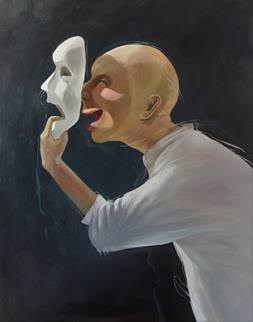Appearances

Jianjun An’s large scale, life-size paintings present a series of ‘types’, figures that combine a number of physical and emotional traits, providing the viewer with insights into how we both present ourselves and are seen by others. An has utilized eighteen individual character types, all contained within their own limited space, defined by the physical parameters of the painting, suggestive of a stage. There are men and women, each depicting the lives of individuals who have immigrated to Canada and who are seen by themselves and others to fit into a specific role within the existing social and cultural milieu of this country. Each identity and distinctive personality trait are effectively portrayed, the exaggerated nature of each figure hinting at the external categorizing that lies beneath all the layers of paint.
In each of the portraits, An inserts a simplified, monochromatic mask into the scene, a version of the classic theatrical comedy and tragedy masks. Masks have been used throughout human history from Africa to Ancient Greece, Commedia Dell’ Arte to Noh Theatre, being utilized in symbolic rituals and within performances of all types. Modern Psychology states that the symbol of the mask indicates the concealment of the ego (or true self) behind a façade that helps to protect the ego and allows us to function in the world. By removing their masks, the characters symbolically reveal their true identities, but the presence of the masks within the paintings suggests that this revelation is fleeting and that our egos and social relationships require us to always have them close at hand.
Through these paintings An proposes that our identities and self-image we put out in the world are constructed internally by our personalities but subject to interpretation and stereotyping by others. The figures present themselves to the world and the viewer in a way that implies a desire for interaction with the viewer; they have their own story to tell and indicate that dialogue between individuals and cultures can help to ‘unmask’ the authentic identity of the subject.
Image: Appearance Series #6, 2018